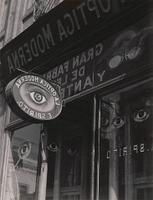Manuel Alvarez Bravo


"parabola optica", 1931[1], and "Striking Worker Assassinated", 1934[2]
from the Getty Museum's bio:
A self-taught photographer, Manuel Alvarez Bravo(1902-2002) purchased his first camera at age twenty while working at a government job. His earliest success at photography came around 1925, when he won first prize in a local photographic competition in Oaxaca. He returned to Mexico City, where he had been born, and in 1927 met Tina Modotti, who introduced him to a lively intellectual and cultural environment of other artists from various disciplines. Among them was Edward Weston, who encouraged Alvarez Bravo to continue photographing; Weston wrote to him in 1929: "Photography is fortunate in having someone with your viewpoint. It is not often I am stimulated to enthusiasm over a group of photographs."
Alvarez Bravo taught photography at the San Carlos Academy in the late 1930s, documented the work of Mexican mural painters including Diego Rivera, and contributed images to the journal Mexican Folkways . His primary subject interests have ranged from the nude form to folk art, particularly burial rituals and decorations.
[1] "parabola" means both parabola and parable in Spanish. Look closely to see the trick of the photo, a sort of visual pun. Courtesy the Getty Museum.
[2] Courtesy Masters of Photography.
both images © Estate of Manuel Alvarez Bravo.





<< Home